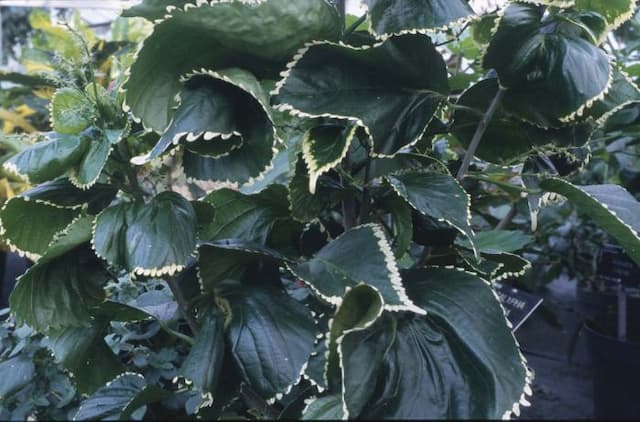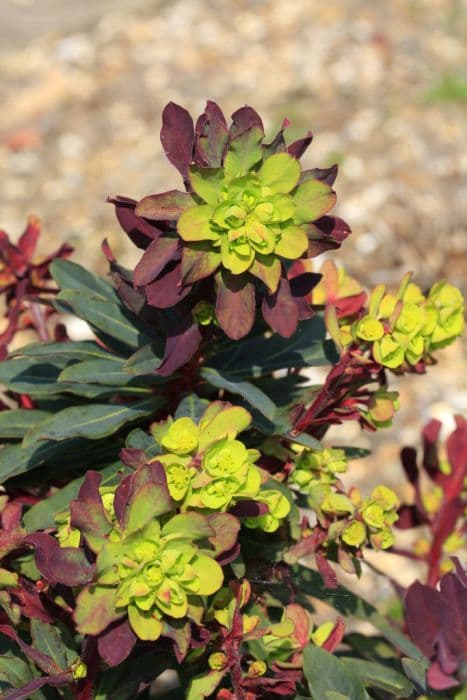Martin's Spurge Euphorbia × martini Tiny Tim = 'Waleutiny'
![Martin's spurge [Tiny Tim]](/_next/image?url=https%3A%2F%2Fplants-admin.emdemapps.com%2Fimages%2Fplants%2F%2Fimages%2F604b54c4403fc.png&w=3840&q=75)
ABOUT
The plant Euphorbia × martini Tiny Tim, commonly known as 'Tiny Tim' spurge, showcases a distinctive and decorative appearance that adds interest to gardens and landscapes. This perennial is evergreen and forms a compact, bushy clump. Its foliage is narrow and lance-shaped, presenting a striking bluish-green color that can add a cooling effect to its surroundings. The leaves exhibit a slight variegation, with occasional hints of lighter green or yellow. One of the most captivating features of 'Tiny Tim' spurge is its floriferous nature; it produces small, showy flowers that cluster together. The flowers are not true flowers in the traditional sense but are specialized structures called cyathia. They are surrounded by eye-catching, petal-like bracts that are typically bright green or yellow-green. These colorful bracts can sometimes have a reddish or pinkish tinge, giving the illusion of the plant being in bloom almost year-round. The plant's overall visual appeal is enhanced by its symmetry and the textural contrast between its flowers and foliage. The rounded shape and the dense leaf coverage make 'Tiny Tim' spurge an attractive option for rock gardens, borders, or as a ground cover. Despite its small stature, this diminutive spurge can become a centerpiece in a garden due to its distinctive coloring and unique floral display.
About this plant
 Names
NamesFamily
Euphorbiaceae.
Synonyms
Martin's Spurge, Tiny Tim Spurge.
Common names
Euphorbia × martini Tiny Tim = 'Waleutiny'.
 Toxicity
ToxicityTo humans
Spurge is considered toxic to humans due to the presence of a milky sap called latex, which is common to members of the Euphorbiaceae family. If any part of the plant is ingested, the toxic sap can cause symptoms such as nausea, vomiting, and diarrhea. More concerning is the sap's potential to cause skin and eye irritation upon contact. If the sap gets into the eyes, it can lead to severe pain and possibly temporary or even permanent blindness if not washed out and medically treated promptly.
To pets
Similar to its effects on humans, spurge is toxic to pets. The milky latex can be harmful if ingested, potentially causing signs such as drooling, vomiting, and diarrhea. If the sap comes into contact with your pet's skin, it might cause irritation, redness, and swelling. In case of eye exposure, the sap can lead to intense pain and eye injuries, possibly resulting in temporary or permanent vision loss. Immediate veterinary care is advised if there is any suspicion that your pet has ingested or come into contact with the sap.
 Characteristics
CharacteristicsLife cycle
Perennials
Foliage type
Evergreen
Color of leaves
Green
Flower color
Yellow
Height
1 foot (30 cm)
Spread
1 foot (30 cm)
Plant type
Shrub
Hardiness zones
7
Native area
Hybrid
Benefits
 General Benefits
General Benefits- Low Maintenance: Martin's Spurge 'Tiny Tim' is a low maintenance plant, requiring minimal care once established.
- Drought Tolerant: It has good tolerance for drought conditions, making it suitable for xeriscaping and water-wise gardens.
- Attractive Foliage: The plant features attractive foliage that provides year-round interest in the garden, with colors intensifying in cooler temperatures.
- Deer Resistant: It is known to be deer resistant, which is beneficial for gardens in areas where deer browsing can be a problem.
- Pest Resistant: Martin's Spurge 'Tiny Tim' tends to have resistance against many common garden pests, reducing the need for chemical treatments.
- Long Blooming: It has a long blooming season, often from spring to summer, providing extended visual appeal.
- Compact Size: Its compact growth habit makes it suitable for small gardens, borders, and containers.
- Versatile: The plant is versatile and can be used in various garden styles including rock gardens, Mediterranean gardens, and cottage gardens.
- Easy to Propagate: It is relatively easy to propagate, allowing gardeners to create more plants from cuttings or division.
 Medical Properties
Medical PropertiesThis plant is not used for medical purposes.
 Air-purifying Qualities
Air-purifying QualitiesThis plant is not specifically known for air purifying qualities.
 Other Uses
Other Uses- Euphorbia Tiny Tim can be used as an educational tool in botany and horticulture classes to teach about hybrid plants and their characteristics.
- In floral arrangements, its unique shape and texture can add an exotic touch to bouquets and decorative centerpieces.
- This plant is suitable for creating drought-tolerant gardens, demonstrating how to garden in water-restricted areas.
- The Tiny Tim can be used in xeriscaping, a landscaping method that reduces or eliminates the need for irrigation.
- It's an ideal candidate for rock gardens, adding a hint of greenery among stones and pebbles.
- The plant can be used as a natural barrier or border when planted in rows due to its compact growth habit.
- In garden design, Tiny Tim provides a striking contrast when paired with plants that have dark foliage or vibrant flowers.
- Euphorbia Tiny Tim can be planted in hanging baskets to create intriguing cascades of foliage from above.
- This cultivar offers a practical solution for ground cover to suppress weeds in sunny areas of the garden.
- It can serve as a living ornament during the festive season, especially when its bracts take on a reddish hue, complementing holiday decor.
Interesting Facts
 Feng Shui
Feng ShuiThe plant Spurge is not used in Feng Shui practice.
 Zodiac Sign Compitability
Zodiac Sign CompitabilityThe plant Spurge is not used in astrology practice.
 Plant Symbolism
Plant Symbolism- Resilience: Euphorbia 'Tiny Tim', like other euphorbias, is known for its toughness and ability to thrive in challenging conditions, symbolizing the human spirit's resilience and perseverance.
- Protection: The Euphorbia genus often exudes a milky sap when cut, which can be irritating to skin and eyes. This natural defense mechanism represents protection and self-defense.
- Purification: Some cultures believe that euphorbias have purifying qualities, using them to cleanse spaces of negative energy and symbolizing the removal of bad influences.
- Healing: Historically, various Euphorbia species have been used in traditional medicine, representing healing and the soothing of ailments.
 Water
WaterMartin's Spurge 'Tiny Tim' should be watered thoroughly whenever the top inch of soil feels dry to the touch, approximately every 7 to 10 days, depending on environmental conditions. When watering, use enough water so that it runs through the drainage holes—a rough estimate would be about half a gallon for a medium-sized pot. Reduce watering in the winter months when the plant is not actively growing, perhaps to every 2 to 3 weeks. Avoid letting the plant sit in water, as this can lead to root rot.
 Light
LightMartin's Spurge 'Tiny Tim' thrives in full sun to partial shade. The best spot for this plant is in a location where it receives at least 6 hours of direct sunlight each day. Ensure that the light is bright but indirect during the hottest part of the day if grown in an area with intense summer sun.
 Temperature
TemperatureMartin's Spurge 'Tiny Tim' prefers temperatures between 60 to 75 degrees Fahrenheit but can tolerate a range from 50 to 80 degrees Fahrenheit. It's not frost-tolerant, so it should be protected or brought indoors if ambient temperatures are expected to drop below 50 degrees Fahrenheit.
 Pruning
PruningMartin's Spurge 'Tiny Tim' should be pruned to remove any dead or yellowing leaves and to maintain its shape. This is best done in late winter or early spring before new growth starts. Light pruning can be done throughout the year as needed. Pruning encourages a bushier growth and prevents the plant from becoming leggy.
 Cleaning
CleaningAs needed
 Soil
SoilSpurge 'Tiny Tim' prefers well-drained soil with a mixture of potting soil, coarse sand, and perlite or pumice. Aim for a soil pH between 6.0 and 7.5.
 Repotting
RepottingSpurge 'Tiny Tim' should be repotted every 2 to 3 years or when it outgrows its current container.
 Humidity & Misting
Humidity & MistingSpurge 'Tiny Tim' is tolerant of a wide range of humidity levels and does not require high humidity to thrive.
 Suitable locations
Suitable locationsIndoor
Place in bright, indirect light and water sparingly.
Outdoor
Plant in full sun to partial shade in well-draining soil.
Hardiness zone
6-9 USDA
 Life cycle
Life cycleEuphorbia 'Tiny Tim', a hybrid of Euphorbia amygdaloides and Euphorbia martinii, starts its life as a seed, which, once sown, germinates in warm conditions to produce a small seedling. With adequate light, water, and nutrients, the seedling grows into a young plant, developing a root system and foliage. As the plant matures, it forms distinctive evergreen foliage and begins to produce its characteristic bracts and small flowers in the spring and summer. Following pollination, either by wind or insects, 'Tiny Tim' may set seed, which can be collected for propagation or allowed to disperse naturally. The plant experiences a period of reduced growth or dormancy in the colder months, although, being evergreen, it retains its leaves. Over several years, with proper care, Euphorbia 'Tiny Tim' forms clumping mounds, and although it may not be a long-lived perennial, it can be propagated through cuttings to continue its life cycle.
 Propogation
PropogationPropogation time
Spring-Early Summer
Euphorbia × martini Tiny Tim, commonly known simply as Martin's spurge, is typically propagated by stem cuttings. The best time to take these cuttings is late spring to early summer when the plant is actively growing. To propagate Martin's spurge using stem cuttings, a gardener should select a healthy stem and cut a 3 to 6 inch (7.6 to 15.2 cm) section. It's crucial to allow the cut end of the stem to dry and callous over for a day or two to prevent rot. Once calloused, the cutting can be planted in a well-draining soil mix and kept in a warm environment with bright, indirect light. The soil should be kept lightly moist until roots develop, which usually occurs within a few weeks. After rooting, the new plant can be gradually acclimated to the same conditions as the mature plants.



![Spurge [Blackbird]](/_next/image?url=https%3A%2F%2Fplants-admin.emdemapps.com%2Fimages%2Fplants%2F%2Fimages%2F604b535f37783.png&w=640&q=75)





